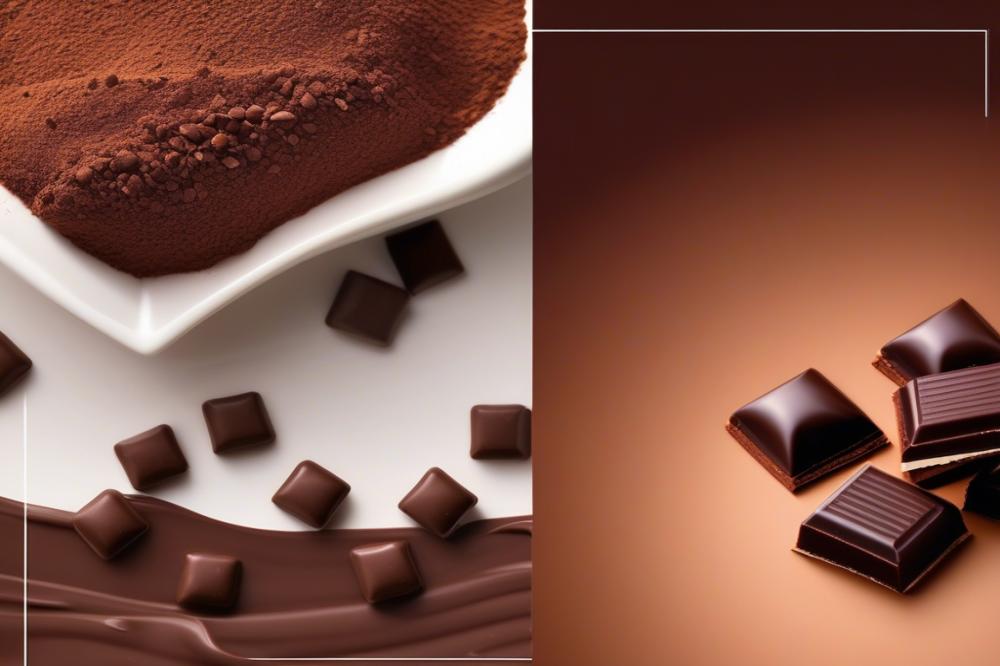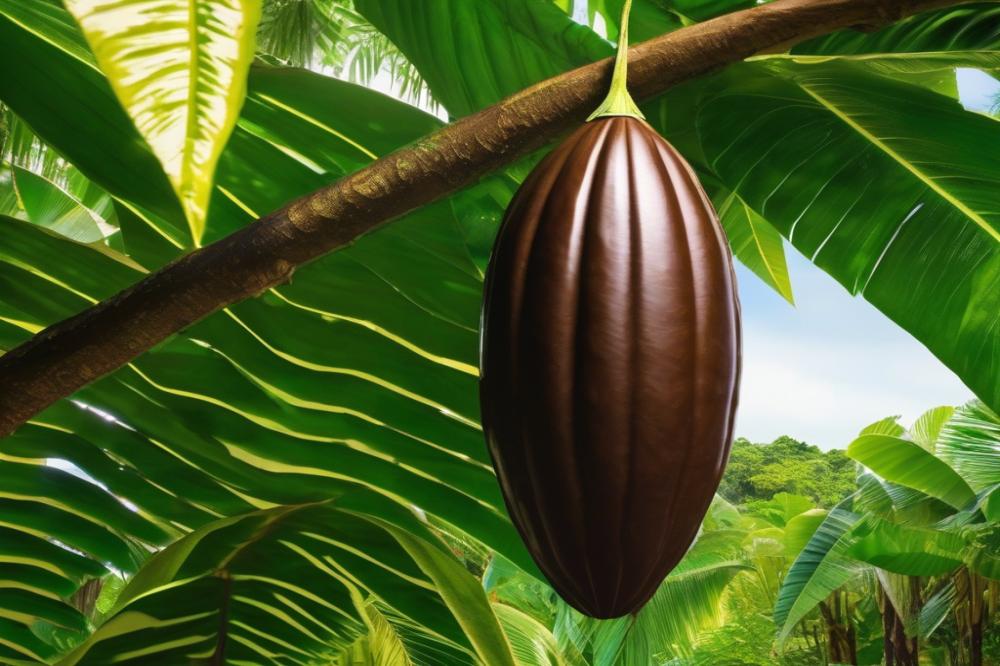Introduction
chocolatebix.com/how-to-make-your-own-cocoa-based-beverages-at-home”>chocolatebix.com/pairing-cocoa-with-other-flavors-a-culinary-guide”>Cocoa and Chocolate are often thought to be the same, yet they differ in many ways. Understanding these differences enriches our knowledge about both, giving us a deeper appreciation for what we consume. It’s essential to grasp how each is made and what they offer, especially when it comes to health and cooking.
Several types of chocolate exist, ranging from dark to milk and even white varieties. In recipes, we often choose specific types depending on the desired flavor and texture. For instance, while Cocoa powder is perfect for baking, chocolate bars can enhance desserts in several ways. Knowing which type of chocolate or cocoa works best can elevate your culinary creations.
Health benefits also play an important role in this discussion. Cocoa boasts impressive properties that can contribute positively to wellness. When comparing it to chocolate, one often finds that the latter might contain added sugars and fats that reduce its nutritional value. Thus, observing how both fit into our diets is crucial.
Baking chocolate serves different purposes compared to what you might eat as a treat. When making chocolate recipes, the right balance between ingredients can lead to delightful results. Moreover, understanding cocoa production provides insight into where our favorite flavors come from. Recognizing the nuances helps make informed choices about what we eat and enjoy.
Cocoa vs. Chocolate
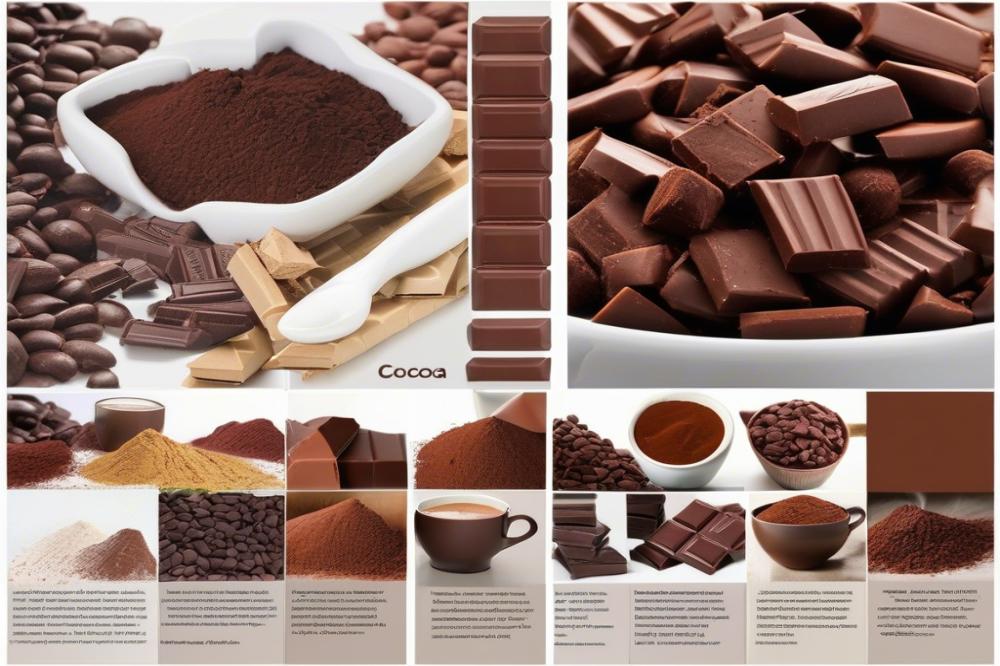
Definition of Cocoa and Its Sourcing
Cocoa is derived from the seeds of the cacao tree. These seeds undergo fermentation, drying, roasting, and grinding. This process produces cocoa mass, which is then pressed to create cocoa powder and cocoa butter. The primary sourcing of cacao happens in tropical regions, particularly in West Africa, Latin America, and Southeast Asia. Farmers cultivate the cacao tree in specific climates, ensuring the beans develop rich flavors.
Explanation of Chocolate and Its Derivation from Cocoa
Chocolate is a delightful treat made from cocoa components. It combines cocoa powder, cocoa butter, sugar, and sometimes milk to create different types of chocolate. This combination produces various flavors and textures, appealing to many tastes. Dark chocolate, milk chocolate, and white chocolate offer unique experiences. Each type has its own percentage of cocoa content, which can dramatically influence flavor.
Key differences Between Cocoa and Chocolate
Understanding the distinctions between cocoa and chocolate is crucial. Cocoa powder lacks the sugar and milk found in chocolate bars. It is mainly used in baking and creating rich chocolate recipes. Chocolate, on the other hand, includes sweeteners and fats, making it more palatable on its own. Additionally, cocoa powder is often regarded as a more intense flavor component, while chocolate provides a sweeter taste profile.
Cocoa Content and Its Impact on Chocolate Flavor
Cocoa content plays a significant role in defining the flavor of chocolate. Higher cocoa percentages often lead to a more robust and less sweet taste. Dark chocolate, for instance, typically contains at least 70% cocoa, giving it a rich, bittersweet flavor. In contrast, milk chocolate has lower cocoa content, which contributes to its creaminess and sweetness. Those who crave intense flavors may lean towards dark varieties. Understanding these differences can help anyone make better choices when selecting chocolate or using cocoa powder in baking.
Types of Chocolate
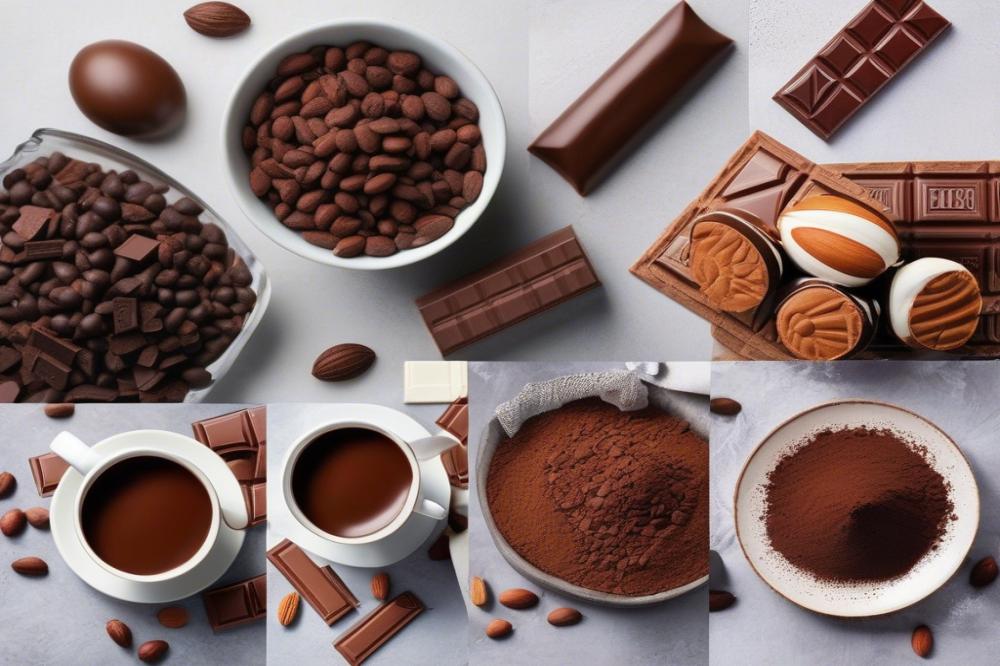
Chocolate comes in various forms, each offering a different taste and experience. Understanding these types of chocolate helps us appreciate the nuances of our favorite treats. The three main categories are dark chocolate, milk chocolate, and white chocolate.
Dark Chocolate
Dark chocolate is often seen as the most sophisticated option. It contains a high percentage of cocoa solids, which gives it a rich, intense flavor. Many people enjoy this type for its potential health benefits. Studies have shown that consuming dark chocolate in moderation can improve heart health, thanks to antioxidants. Individuals seeking a deep, bittersweet taste often gravitate towards dark chocolate bars.
Milk Chocolate
Milk chocolate is probably the most popular choice around the world. This kind blends cocoa solids with milk solids and sugar, resulting in a creamier texture. The sweetness balanced with the chocolate flavor appeals to many. Milk chocolate is frequently used in baking recipes and as a common ingredient in candy bars. Its lighter taste makes it a favorite among those who prefer milder sweets.
White Chocolate
White chocolate is unique because it does not actually contain cocoa solids. Instead, it is made from cocoa butter, sugar, and milk. Some argue that it shouldn’t even be called chocolate, as it lacks the key ingredient that gives chocolate its signature flavor. However, many enjoy white chocolate for its sweet, buttery taste. It’s often found in desserts and confections, providing a different flavor profile for those who like sweetness without the bitterness of cocoa.
Role of Cocoa in Different Types of Chocolate
Cocoa plays a vital role in defining the character of chocolate. In dark chocolate, the cocoa content is usually high, ranging from 60% to over 90%. This gives it a robust flavor, making it perfect for those who enjoy depth. Milk chocolate typically contains less cocoa, often between 10% and 50%. Consequently, its flavor leans more toward sweetness than richness. White chocolate skips cocoa solids entirely, focusing on cocoa butter instead.
Cocoa Content Variation
When looking at the different types of chocolate, cocoa content is key. Higher cocoa percentages generally lead to a more intense chocolate flavor. This is crucial for chocolate enthusiasts who seek bold experiences. Chocolates with lower cocoa percentages tend to be sweeter and creamier, appealing to those who prefer a softer taste. Choosing the right chocolate can enhance any chocolate recipes or baking chocolate endeavors.
Cocoa Powder and Baking Chocolate
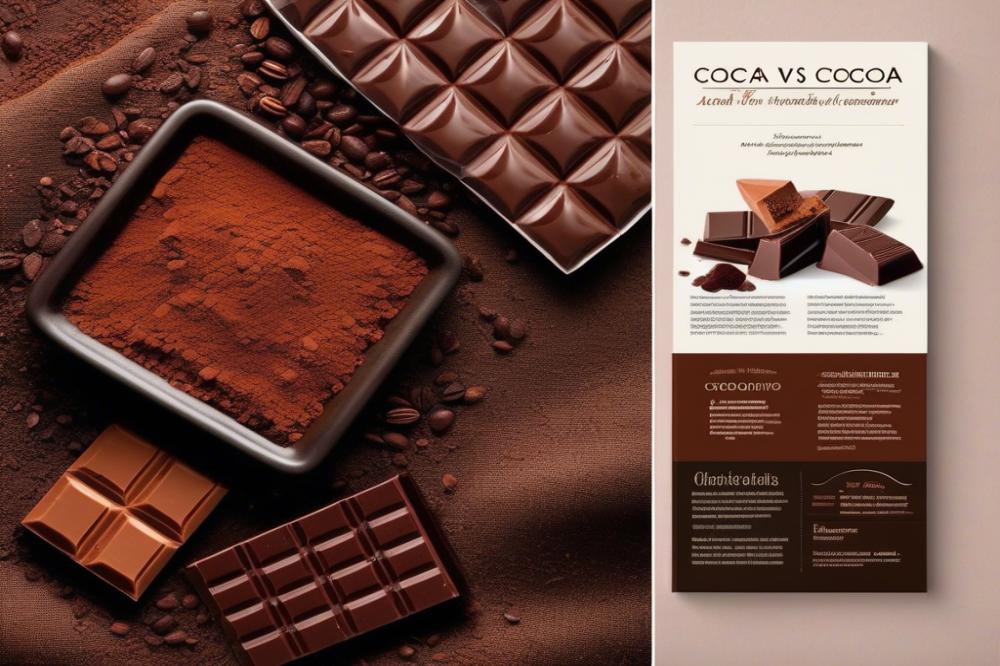
Definition and Usage of Cocoa Powder
Cocoa powder is created by grinding cocoa beans after the fat has been removed. This results in a fine powder packed with chocolate flavor and antioxidants. Many bakers and chefs use cocoa powder to enhance desserts without adding excessive richness. It is perfect for cookies, cakes, and even frostings. You can find it in various recipes, from brownies to hot cocoa. Most importantly, cocoa powder adds a deep chocolatey taste without the added sugar found in some chocolate bars.
Difference Between Cocoa Powder and Chocolate Bars
There are key differences between cocoa powder and chocolate bars. Chocolate bars often contain sugar, cocoa butter, and milk in addition to cocoa solids. This means they bring sweetness and creaminess to dishes. In contrast, cocoa powder lacks those extra ingredients, making it drier and more intense. When you use cocoa powder in baking, you control the sweetness. This allows for a balance that is sometimes lost when using actual chocolate bars. Consider cocoa powder as a concentrated version of chocolate in your recipes.
Baking Chocolate and Its Relationship with Cocoa
Baking chocolate refers to unsweetened chocolate made from cocoa solids and cocoa butter. It is often used in deeply flavored chocolate recipes. Chefs add sugar later to achieve desired sweetness. While baking chocolate and cocoa powder share similar origins, they have different uses in the kitchen. If you’re looking for a melted chocolate effect, baking chocolate is the way to go. However, when you desire a lighter texture or deeper chocolate flavor without the richness, cocoa powder shines through.
Popular Baking Recipes Using Cocoa
Many beloved recipes simply wouldn’t be the same without cocoa powder. Think about brownies—rich and fudgy, they rely on cocoa for that indulgent depth. Chocolate cakes also benefit greatly from its strong flavor. Other favorites include chocolate puddings and mousses, which can use cocoa to enhance their richness while maintaining a smooth texture. Even cookies can get a makeover by incorporating cocoa powder. Bakers love how it blends seamlessly into batter while boosting the overall taste. With countless chocolate recipes reliant on this ingredient, it’s hard to overstate its importance in the world of baking.
Health Benefits of Cocoa
Nutritional Profile of Cocoa
The nutritional profile of cocoa is impressive. It contains essential minerals like magnesium, iron, and potassium. Cocoa is also rich in antioxidants, which protect the body from harmful free radicals. This ingredient is found in various forms, including cocoa powder and baking chocolate. People often overlook the importance of these components in maintaining overall health.
Health Benefits Associated with Cocoa Consumption
Regular consumption can yield many health benefits. For starters, cocoa supports better blood flow. Its unique compounds may lower blood pressure, making it helpful for cardiovascular health. Studies also suggest that cocoa can enhance insulin sensitivity. This means it may play a role in reducing the risk of type 2 diabetes. Furthermore, the presence of flavonoids contributes to a robust immune system.
Impact of Cocoa on Heart Health and Mood
Cocoa promotes heart health in more ways than one. The flavonoids found in cocoa can reduce inflammation and improve cholesterol levels. Hence, enjoying chocolate recipes that focus on high cocoa content is a tasty way to boost heart health. On the mood front, cocoa may have mood-lifting effects. It triggers the release of endorphins, the body’s feel-good hormones. So, indulging in dark chocolate bars or cocoa drinks might help uplift a person’s spirits after a tough day.
Comparing the Health Benefits of Cocoa and Chocolate
Differences exist between cocoa and chocolate when considering health benefits. While chocolate often contains added sugars and fats, cocoa is more concentrated in nutrients. Dark chocolate can be a healthier option due to its higher cocoa content compared to milk chocolate. Cacao and cocoa are related, but cacao often retains more nutrients. Chocolate lovers can enjoy a variety of flavors, yet they should choose products wisely. Higher cocoa percentages usually indicate more antioxidants and less sugar. Therefore, opting for products like unsweetened cocoa powder can maximize health advantages while minimizing sugar intake.
Cocoa Production and Cacao
Overview of Cocoa Production Process
The journey of turning cacao beans into delightful products begins with careful harvesting. Cacao trees thrive in warm, tropical climates. After harvesting, the beans undergo fermentation. This crucial step develops the rich chocolate flavor we all enjoy. Next, the beans are dried to prepare them for shipping. Roasting follows, which enhances the aroma and taste. Grinding the roasted beans releases cocoa butter and produces cocoa mass. From here, various types of chocolate can be created, including chocolate bars and baking chocolate. Every stage is important to achieve the final product, whether it’s cocoa powder or a decadent chocolate treat.
From Cacao Bean to Cocoa Product
Transforming a cacao bean into a consumer-ready cocoa product is no small feat. Once the beans are fermented and dried, they are carefully roasted to bring out their inherent flavors. During grinding, the process separates cocoa solids from cocoa butter. The solids are what become cocoa powder. Cocoa powder serves as a vital ingredient in many chocolate recipes, contributing to desserts and beverages. Meanwhile, the cocoa butter adds richness and smoothness to chocolate bars. Understanding these steps highlights why some products taste different and have unique textures.
Regions Known for Cacao Cultivation
Cacao cultivation primarily occurs in regions near the equator. Countries like Ivory Coast, Ghana, and Indonesia are major producers. Each of these regions offers distinct flavors due to varying soil types and weather conditions. Farmers in these areas dedicate their lives to growing cacao trees. The commitment of these growers is crucial for maintaining a consistent supply of quality beans. Supporting cacao growers helps foster sustainability and ethical practices in production.
Sustainability and Ethical Considerations in Cocoa Production
Sustainability is an increasingly important topic in cocoa production. Many consumers are concerned about the ethical implications of their chocolate choices. Cacao farming often faces challenges, including deforestation, child labor, and low wages for farmers. Some companies are taking steps to improve their practices. They are committing to fair trade and sourcing cacao sustainably. By choosing responsibly produced chocolate, you can make a positive impact. Exploring the differences among chocolate types becomes more meaningful when you know the story behind the product. Ethical consumption is not just a trend; it’s a necessity for the future of this beloved treat.
Chocolate Recipes and Uses
Popular Recipes that Highlight Cocoa
Many delicious recipes showcase cocoa. Brownies are a classic choice. They can be rich and fudgy, or cake-like, depending on the method. Hot cocoa is another favorite. It warms you up and is perfect for chilly days. You can make it creamy or keep it light. Cookies made with cocoa powder also stand out. These treats are often soft and chewy, loved by all ages. Cakes, especially chocolate layers, are simply irresistible. Adding cocoa powder to a batter elevates the flavor to new heights.
Diverse Uses of Chocolate in Cooking and Baking
Chocolate is incredibly versatile in cooking. While chocolate bars are perfect for snacking, they also melt beautifully for desserts. Truffles and ganaches took center stage in fancy celebrations. In savory dishes, dark chocolate enhances flavors, especially in chili. The differences among types of chocolate can influence recipes. Milk chocolate offers sweetness, while dark chocolate carries boldness. Pairing the right type with your dish creates harmony. From molded candies to cake frosts, the options are endless.
Tips for Incorporating Cocoa into Everyday Recipes
Incorporating cocoa powder into meals can be simple. You can add it to smoothies for a chocolate flavor boost. Oatmeal becomes richer when you sprinkle in cocoa. Use it in marinades for meats to add depth. Even pancakes can taste extraordinary with a hint of cocoa. Strength lies in balance, so start with small amounts. Additionally, experiment with chocolate chips in trail mixes or snack bars. The health benefits of cacao can also influence your choices. Always opt for higher-quality chocolate for the best outcomes. This can enhance your dishes while also providing nutrients. Making small adjustments opens new possibilities in the kitchen.
Final Thoughts on Cocoa and Chocolate
Throughout this article, we have explored the differences between cocoa and chocolate. Understanding these distinctions enhances our appreciation for both ingredients. Cocoa is derived from the cacao bean, while chocolate is a product made with cocoa, sugar, and other components. Different types of chocolate, such as dark, milk, and white, offer an array of flavors and textures, making them versatile for culinary use.
From a health perspective, the two substances present unique benefits. Cocoa is often celebrated for its antioxidants and potential heart health properties. On the other hand, chocolate can vary greatly in nutritional value depending on its sugar and cocoa content. Choosing high-quality chocolate can provide some health benefits while satisfying your sweet tooth.
Exploring both cocoa and chocolate can enhance your diet. Each offers unique flavors and health benefits that can complement a balanced lifestyle. Consider incorporating them into your meals or snacks. Whether you prefer the rich essence of cocoa or the delightful taste of chocolate, both can play a role in your culinary adventures.

